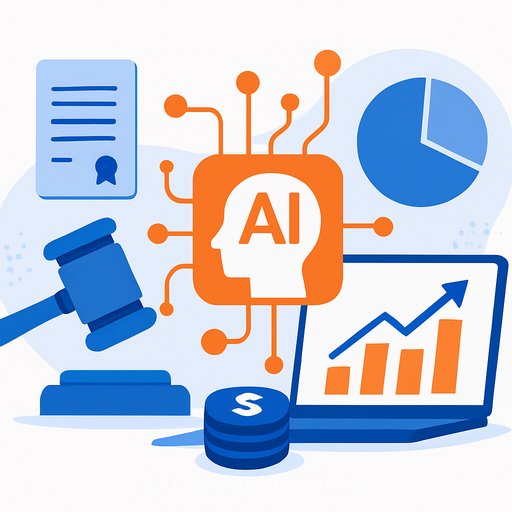Can C3.ai's New Leadership Restore Trust and Transparency Amid Legal and Operational Challenges?
C3.ai reported a weak fiscal Q1, withdrew full-year guidance, announced a CEO transition due to health reasons, and now faces multiple class action lawsuits alleging misleading statements. That mix puts trust, disclosure quality, and execution back at the center of the story.
For Legal and Operations teams, the question is simple: what does this mean for risk, contracts, and delivery if you are evaluating or already deploying C3.ai's software?
What Changed-and Why It Matters
With guidance pulled, external visibility is limited, and leadership change introduces execution risk. The near-term priority shifts to proof of predictable sales cycles and contract quality, not headlines.
Management highlighted the C3 AI Agentic Process Automation platform as a growth lever. If it converts pilots to recurring deployments, it can stabilize revenue and margins. The burden is on measurable outcomes, not promises.
Trust and Disclosure: What Legal Teams Should Look For
- Clear reinstatement of guidance with explicit assumptions and sensitivity ranges.
- Updated risk factors and internal controls discussion in the next 10-Q/8-K filings.
- Independent board statements on oversight, audit committee engagement, and any remediation plans.
- Plain-English revenue recognition policies (ASC 606), backlog/RPO definitions, and non-GAAP reconciliations.
- Timely disclosures on litigation exposure, reserves, and insurance coverage.
Context: securities claims typically hinge on alleged material misstatements or omissions. See Rule 10b-5 for the standard on fraud-based claims here, and the safe harbor for forward-looking statements here.
Litigation Overhang: Practical Risk Assessment
- Base case: cases dismissed or settled with limited cash impact; distraction remains a factor.
- Adverse case: class certification plus settlement or extended discovery raises costs, management time, and reputational drag.
- Ask for status updates on class actions, expected timelines, and reserves.
- Review D&O insurance limits, exclusions, and insurer financial strength.
- Confirm vendor indemnities, caps, and carve-outs for securities-related issues (often excluded).
Operations: Making the "Agentic Process Automation" Pitch Real
- Integration: how it sits with your current RPA/IPA stack (e.g., orchestration, connectors, eventing, exception handling).
- Controls: role-based access, audit logs, human-in-the-loop approvals, prompt/content filtering, and data residency.
- Model risk: output traceability, evaluation datasets, hallucination/error rates, rollback plans, and incident response SLAs.
- Conversion metrics: pilot-to-production rate, average time-to-value, and renewal/expansion data by cohort.
If your team is building internal capability around automation, these practical resources may help: Automation use cases and courses.
Procurement and Contract Checklist
- Service reliability: uptime SLA, service credits that scale, and chronic breach provisions.
- Data rights: your data stays yours; no training on your data by default; secure deletion on exit; export formats and APIs guaranteed.
- Security: SOC 2 Type II, pen-test summaries, vulnerability fix SLAs, and third-party subprocessor list with notice rights.
- IP and AI outputs: IP indemnity for claims tied to training data and generated outputs; open-source compliance warranties.
- Performance milestones: staged payments tied to measurable outcomes; exit clauses if milestones slip.
- Pricing: price holds for renewals, usage ceilings, and guardrails on overages; audit rights for usage metering.
- Change clauses: notice for material org or leadership changes; termination for convenience with reasonable wind-down.
- Transition assistance: knowledge transfer, data extraction, and runbook handoff on termination.
Outlook and Valuation Markers
The current scenario points to $613.6 million in revenue and $80.3 million in earnings by 2028, implying 16.4% annual revenue growth and a $369 million swing from -$288.7 million today. A modeled fair value of $14.67 suggests a 23% downside to the current price.
Community fair values span roughly US$13 to US$42.60 per share, underscoring the split view on execution and profitability. With guidance withdrawn and ongoing losses, expect continued disagreement until disclosures and results improve.
What to Watch Over the Next 2-3 Quarters
- Reinstatement of guidance and the quality of assumptions shared.
- Pilot-to-paid conversion rate and net retention.
- Backlog/RPO growth versus billings and cash flow inflection timing.
- Deal quality: term length, ramp schedules, federal exposure, and services mix.
- Leadership communication cadence and turnover in sales or engineering.
- Litigation milestones: motions to dismiss, class certification, or settlement discussions.
Bottom Line
Trust is the constraint. Clear disclosures, consistent delivery, and clean contracts will move the needle more than product demos.
If you are a buyer, protect outcomes with milestone-based contracts, data safeguards, and termination flexibility. If you are an investor, the next few quarters hinge on conversion, cash discipline, and transparency.
This article is for information only and is not legal or financial advice.
Your membership also unlocks:










